Ikebana: The Artful Soul of Japanese Flower Arrangement
The Japanese art of ikebana goes beyond flower arrangement. It involves ancient techniques that take several years to master. Here’s your chance to find out the true meaning and essence of ikebana in Japan.
Ikebana, Japan's Spiritual Floral Art

Ikebana is Japan’s art of arranging flowers, leaves, and stems into a container, typically a vase. Unlike Western flower arrangements, which focus on symmetry, Ikebana embraces and even encourages asymmetry. To master ikebana, one must learn the different techniques for fastening and positioning flowers and stems, which could take three to five years of studying at a school (ryuha). Ikebana arrangements are used to decorate traditional homes, demonstrate respect for nature, and improve the spirituality of its practitioners. Ikebana is one of the three classical Japanese arts of refinement. The other two are kodo (the art of incense appreciation) and chado (the art of tea ceremony).
Common flowers used for ikebana are cherry blossom, bamboo, chrysanthemum, iris, and pine. Ikebana’s significance in Japanese culture goes beyond mere flower arrangement. It represents the harmonious relationship between the floral materials and their immediate environment. It also serves as a way to preserve culture by passing down knowledge and techniques from one generation to another.
Today, ikebana maintains its status as a disciplined art form deeply rooted in Japanese philosophy and aesthetics. However, it has evolved into a modern version that uses innovations and contemporary styles.
In this post, we'll explore everything there is to know about Ikebana in Japan, from its history to styles, tools, and preservation efforts. Let’s get started!
The History and Evolution of Ikebana in Japan

Ikebana’s origins date as far back as the 6th century. Buddhist rituals involved floral offerings at the altar. While Indian Buddhism used the lotus as an offering, the practice in Japan involved the use of different native flowers for each season.
Proper ikebana began at the start of the Muromachi Period (1336) with a simple kuge style of a few stems and evergreen branches. This period also marked the beginning of other Japanese arts of refinement. Groups of artists known as doboshu served the elite at the time. They were left in charge of aesthetics, and some of them chose to perform their duties through flower arrangements. This led to the creation of the style of placing a standing branch in the center of a vase, tatebana. Ikenobo Senkei, a Kyoto monk, became famous for his tatebana style. The oldest school, Ikenobo, was also established in this period. It’s worth noting that ikebana was a male-only art form throughout these eras.
Ikebana continued to evolve with new styles being added, all the way into Japan’s entry into the Edo period (1603). It was at this time that the art form underwent its biggest changes. Many schools were established to teach both new and old styles, including rikka, seika, etc. The Meiji period (1868–1922) came with massive modernization that threatened to eradicate the practice of ikebana. However, a government initiative to educate women by teaching them ikebana was enough to revive interest in the art. By the late 19th century, many more styles had been established, including moribana, one that incorporated Western flowers. In 1956, Ikebana International, a non-profit tasked with promoting the art form within and outside Japan, was established.
Understanding Ikebana: Principles and Styles
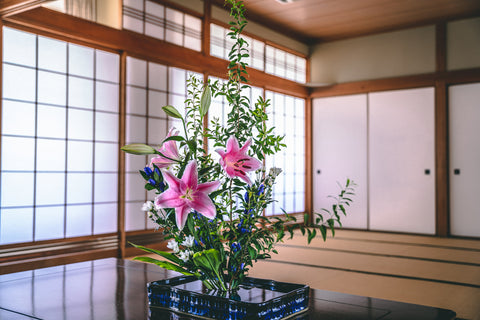
The first step to understanding ikebana is knowing its various principles, after which you can move on to learning about the major styles. These principles can be perceived as rules that govern the art of Japanese flower arranging, and they guide all ikebana artists, irrespective of the schools they attend or the styles they showcase.
The 7 Principles of Ikebana
All major Ikebana schools follow seven foundational rules or principles of flower arrangement. They are:
-
Silence: You should avoid idle gossip and remain silent during flower arrangements.
-
Minimalism: Flower arrangements should be aesthetically bare, following Buddhist minimalist ideals.
-
Shape and Line: The shape and alignment of the ikebana arrangement should complement the space.
-
Form: You should never plan the form of the flower arrangement, but rather, it should be a natural reflection of your feelings and mood.
-
Humanity: All human elements, including the creator and observers, are part of the artwork.
-
Aesthetics: Ikebana is deeply rooted in Japanese aesthetics, appearing simple but complex.
-
Structure: The flower arrangement should follow a triangular framework, with three points representing heaven (shin), earth (hikae), and humanity (soe).
The Major Styles and Schools of Ikebana
Ikebana styles define the dimensions, structure, and type of plants used in a single flower or arrangement. Below is a list of some of the major styles in Japan.
-
Rikka (standing flowers): This is a 3D arrangement made up of seven to nine branches that represent the elements of nature and its seasonal changes.
-
Moribana (piled-up flowers): This style focuses on arrangements with foreign plants.
-
Shoka (living flowers): This is a simple arrangement with three lines and three plants.
-
Jiyuka: This is free-style ikebana, with no regard for formalities and an emphasis on individual creativity.
-
Seika: This is the ancient form of arrangement based on the triangular structure of heaven-earth-mankind (ten-chi-jin, jo-ha-kyu, or shin-gyo-so).
Every ikebana school defines its own set of styles, forms, and guidelines for flower arrangement. Some of the major schools in Japan are Ikebono, Ohara, and Sogetsu.
The Tools of the Trade: Essential Ikebana Supplies
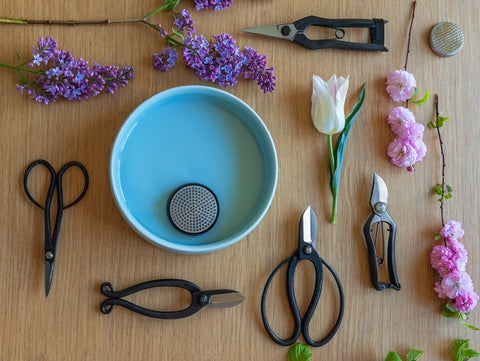
As with any artist, an ikebana practitioner requires essential tools and materials. The most important of them all are the flowers, stems, and leaves used for the arrangement. They include the following plants: bamboo, plum, apricot, quince, chrysanthemum, bittersweet, wintersweet, nandina, iris, peach, pine tree, weeping willow, camelia, and narcissus.
The next thing you'll need are special vases or bowls to arrange the plants in. Ikebana vases can be made of ceramic, metal, or bamboo. Alternatives are bamboo baskets and slate vases. Most of the containers used for Japanese ikebana are waterproof.
You’ll also need some ikebana shears or scissors capable of cutting different kinds of materials, from delicate elements to thick branches. Kenzan (flower frog) is another essential tool to have. It’s a steel or brass material used to anchor stems, branches, and leaves in vases.
Ikebana Today: Contemporary Practices and Trends

Ikebana is still very relevant in modern times, thanks to its ability to evolve with the times. The art has adapted to contemporary tastes and trends in various ways. One of them is the increasingly popular use of non-traditional materials. 21st century artists use plastic objects, metal wires, recycled pieces, and other unexpected materials to showcase a more playful and creative display of ikebana flower arrangements. These modern artists also incorporate natural elements such as rocks, moss, and driftwood. Other contemporary trends are focused on the same classic minimalist styles of ancient Japan. They make the most of the space to create calming minimalist beauty, particularly in residential environments.
Ikebana as Meditation: The Therapeutic Benefits
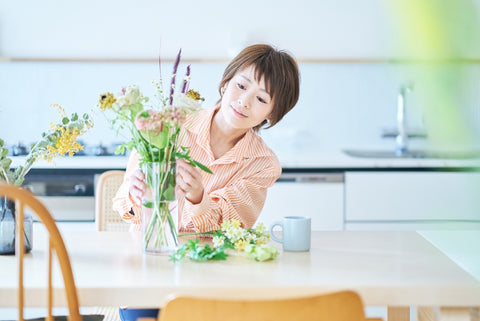
Ikebana offers therapeutic benefits for both practitioners and observers. It promotes mindfulness by encouraging you to focus on the task while unlocking the creativity within you. It’s a unique form of active meditation, and many people say that they become so engrossed in the flower arrangement that they don’t realize they’re meditating until the end of the session.
Ikebana also serves as a way for you to relax after a stressful day. In today’s fast-paced era, lots of people of all ages can improve their emotional well-being by practicing the art or placing such flower arrangements in their living spaces.
Seasonal Sensitivity: Ikebana and the Japanese Concept of Time

Many of the naturally-grown plants used for ikebana in Japan are associated with their blooming seasons. These arrangements help to acknowledge and appreciate the seasonal changes that take place in nature. In fact, symbolism and seasonality are core parts of traditional ikebana. Bamboo grass is a year-round favorite, but pine branches are more common in the new year. During the spring, iris, cherry blossom (sakura), and narcissus are the favored ikebana elements. You’ll find chrysanthemum in abundance in the autumn. These seasonal concepts are no longer exclusive to traditional ikebana, as modern practices also follow them. Some people even use flowers that are out of bloom to add a contrasting twist to their arrangements.
Mastering Ikebana: Learning and Certification in Japan

If you find ikebana intriguing enough to learn, you can easily enroll in a program and get started with the basics, even if you don’t speak Japanese. Many of the most famous schools in the country offer courses in English, Japanese, and other languages.
-
Ohara School: Established in 1912, the school is famous for inventing the moribana style, a pioneer of modern ikebana. It offers weekly classes in Minami-Aoyama, Tokyo.
-
Sogetsu School: Since 1927, the school has been a beacon of free-flowing creativity in ikebana. It offers a variety of trial and introductory classes in Akasaka, Tokyo.
-
Ichiyo School: The school teaches ichiyo seika, nageire, and moribana styles at its headquarters in Nakano, Tokyo. It was founded in 1937.
At the end of the course, you’ll get an introductory certificate. To earn a professional certificate from the school’s Japanese headquarters, you’ll need to enroll in courses that last nearly three years. A professional certificate is mandatory to become an ikebana teacher. In most cases, you cannot apply for certification on your own. Only your teacher can do so.
Ikebana Exhibitions: Where to View Masterpieces
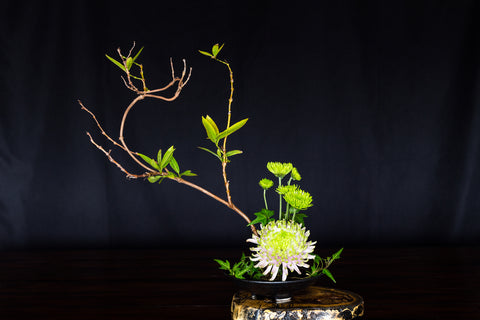
If you need to view stunning Japanese flower arrangements and meet practitioners of the art, you should attend the dozens of exhibitions and events that take place throughout the year. Ikebana International is a major sponsor of these events. Check out the most popular Ikebana exhibitions and events below:
-
Hatsuike Ceremony (January): Hundreds of ikebana disciples from all around the world gather at the Ikenobo Headquarters in Kyoto to showcase their works.
-
Ikenobo Tokyo Exhibition (Mid to Late May): Artists and observers gather at the Ikenobo Headquarters in Tokyo to enjoy various floral works in a six-day ceremony.
-
Ikenobo Annual National Convention in Osaka (Mid May): Every year, the Osaka International Conference Center greets thousands of ikebana enthusiasts.
-
Ikenobo Fukuoka Exhibition (Late September): The gathering takes place at the Iwataya Main Store in Fukuoka.
Ikebana Influences: The Art's Impact Beyond Japan

Thanks to ikebana flower arrangement, the world now has a greater appreciation for Japanese aesthetics. It has become an art form that encourages the use of simplicity, minimalism, and natural elements in floral art and design, irrespective of the location. Its use of seasonal flowers has also had a big impact on how artists in other countries depict the beauty and symbolism of nature in their works. Few art forms encourage creative expression as well as ikebana, and floral designers recognize this. Hence, you’ll find that contemporary floral art styles are a lot more expressive.
Preserving Tradition: The Future of Ikebana in Japan and Abroad

Several non-profit organizations have taken steps to preserve and promote the art among younger generations in Japan and the rest of the world, but none are as important as Ikebana International. Today, the organization has 161 chapters and 7,000+ members in 50 countries. Their influence and that of the Japan Ikebana Arts Association led to the establishment of Ikebana Day in 2021. June 6 is dedicated to the ancient culture and is believed to be the ideal day to learn ikebana or any other Japanese art.
Ikebana as a Window to Japanese Culture
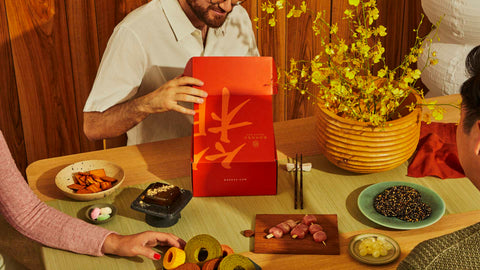
Ikebana offers a unique window into Japanese culture, blending art, nature, and spirituality in a practice that continues to captivate and inspire. Other Japanese practices, like tea ceremonies and incense appreciation, can also provide you with more insights. Let’s help you experience the true essence of Japanese tea and the snacks that appear in the ceremonies. Get yourself a Bokksu Snack Box subscription, and we’ll send you authentic snacks, sweets, and teas every month.
Author Bio











